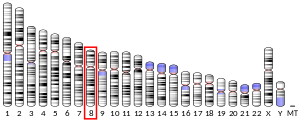HSF1
HSF1열충격인자 1(HSF1)은 인체에서 HSF1 [4]유전자에 의해 암호화되는 단백질이다.HSF1은 진핵생물에서 고도로 보존되며 발달 및 [5]신진대사와 같은 비스트레스 조절에서 중요한 역할을 하는 단백질 독성 스트레스에 대한 전사 반응의 1차 매개체이다.
구조.
인간 HSF1은 결합과 활동을 규제하는 여러 도메인으로 구성됩니다.
DNA결합 도메인(DBD)
약 100개의 아미노산으로 이루어진 이 N 말단 도메인은 HSF 단백질 제품군에서 가장 보존성이 높은 영역이며 나선-턴-나선 루프로 구성됩니다.각 HSF1 단량체의 DBD는 표적 DNA의 배열 nGAan을 인식한다.nGAAn 펜타머의 반복 배열은 활성 HSF1 트리머가 [6]결합하기 위한 열충격요소(HSE)를 구성합니다.
올리고머화 도메인(류신 지퍼 도메인)
HSF1 단량체 간의 올리고머화를 담당하는 2개의 영역은 류신 지퍼(LZ) 도메인 1-3 및 4입니다[7](이 영역들은 일반적으로 HR-A/B 및 [6]HR-C라고도 불립니다).LZ1-3은 DBD의 바로 다운스트림에 위치하며, LZ4는 RD와 C 터미널 TAD 사이에 있습니다.비스트레스 조건 하에서 자발적인 HSF1 활성화는 LZ1-3과 LZ4의 상호작용에 의해 부정적으로 규제된다.응력에 의해 유도되면 LZ1-3 영역은 LZ4 영역에서 이탈하여 다른 HSF1 LZ1-3 도메인과 트리머를 형성하여 트리플 코일 코일을 [7]형성합니다.
규제 구역(RD)
HSF1의 C단말기 RD 및 TAD의 구조는 동적인 [8]특성 때문에 명확하게 해결되지 않았습니다.그러나 RD는 올리고머화 도메인의 두 영역 사이에 있는 것으로 알려져 있다.RD는 스트레스가 없는 상태에서 TAD를 억제함으로써 음성 제어를 통해 TAD를 조절하는 것으로 나타났습니다. 이 역할은 번역 [6][7]후 수정을 통해 유도적으로 조절됩니다.
트랜스 액티베이션 도메인(TAD)
이 C 말단 영역은 HSF1 단백질의 마지막 150개의 아미노산에 걸쳐 있으며 2개의 TAD(TAD1 및 TAD2)를 포함합니다.아미노산 401-420에 있는 TAD1은 대체로 소수성이며 알파 나선 형태를 띠게 될 것으로 예상된다.TAD1은 HSF1의 전사 활성화를 지시하기 위해 표적 DNA와 직접 상호작용하는 것으로 나타났다.TAD2의 구조인 아미노산 431-529는 소수성 및 산성 [6]잔류물과 더불어 프롤린 잔류물을 포함하고 있기 때문에 헬리컬하지 않을 것으로 예상된다.HSF1 TAD의 기능은 아직 거의 특징지어지지 않았지만 Hsp70은 이 도메인과 바인드되어 있는 것으로 나타나 Hsp70이 HSF1을 [7]부정적으로 규제하는 메커니즘을 설명할 수 있습니다.
기능.
HSF1 단백질은 열충격 단백질의 주요 전사 인자로 작용하여 인간의 열충격 반응 경로를 조절합니다.HSR은 세포 내에서 단백질의 적절한 접힘과 분포를 보장함으로써 보호 역할을 한다.이 경로는 온도 스트레스뿐만 아니라 저산소 조건 및 오염 [7]물질에 대한 노출과 같은 다양한 다른 스트레스 요인에 의해 유도됩니다.HSF1은 열충격, DNA 손상 복구, 신진대사와 관련된 많은 세포 보호 단백질의 유전자를 변환합니다.이는 열충격 반응뿐만 아니라 노화 및 [7]질병에서도 HSF1의 다목적 역할을 보여줍니다.
작용 메커니즘
비스트레스 조건 하에서 HSF1은 주로 핵과 세포질 전체에 위치한 비활성 단량체로 존재한다.단량체 형태에서는 히트쇼크 단백질 Hsp70, Hsp90, TRiC/[7][9]CCTV 등의 샤페론과의 상호작용에 의해 HSF1 활성화가 억제된다.열충격 등 단백질 독성 스트레스 발생 시 이들 샤페론은 HSF1에서 방출되어 단백질 접힘 역할을 수행함과 동시에 HSF1의 세포질으로의 수출을 억제한다.이러한 작용은 HSF1이 표적 [6][7][10]유전자의 전사를 자극하기 위해 삼량화되고 핵에 축적되도록 한다.
임상적 의의
HSF1은 암과 [11]프로테오파시의 유망한 약물 대상이다.
열충격 상태에서 HSF1에 의해 활성화된 유전자는 최근 악성 암세포에서 활성화된 유전자와 다른 것으로 나타났으며, 이 암 특이적 HSF1 유전자는 유방암에서 나쁜 예후를 나타냈다.독특한 방식으로 HSF1을 사용하는 암세포의 능력은 이 단백질을 치료와 예측에 [12]중요한 임상적 의미를 부여한다.
그러나 헌팅턴병(HD)과 같은 단백질 접힘 질환의 경우, 열충격 반응 경로를 유도하는 것이 유익할 것이다.최근에는 HD에서 발견되는 폴리글루타민 확장을 발현하는 세포를 사용하여 열충격 후 HSR과 HSF1 수치가 모두 감소하는 것으로 나타났다.스트레스에 반응하는 병든 세포의 감소된 능력은 특정 [13]질병과 관련된 독성을 설명하는데 도움을 준다.
상호 작용
HSF1은 다음과 상호작용하는 것으로 나타났습니다.
CEBPB,[14] HSF2,[15] HSPA1A,[16][17] HSPA4,[18][19] 히트쇼크단백질 90kDa 알파(세포산) 부재 [20][18]A1, NCO6,[21] RALBP1[20], 및 SYMPK.[22]
「 」를 참조해 주세요.
레퍼런스
- ^ a b c ENSG00000284774 GRCh38: 앙상블릴리즈 89: ENSG00000185122, ENSG00000284774: Ensembl, 2017년 5월
- ^ "Human PubMed Reference:". National Center for Biotechnology Information, U.S. National Library of Medicine.
- ^ "Mouse PubMed Reference:". National Center for Biotechnology Information, U.S. National Library of Medicine.
- ^ Rabindran SK, Giorgi G, Clos J, Wu C (August 1991). "Molecular cloning and expression of a human heat shock factor, HSF1". Proceedings of the National Academy of Sciences of the United States of America. 88 (16): 6906–10. Bibcode:1991PNAS...88.6906R. doi:10.1073/pnas.88.16.6906. PMC 52202. PMID 1871105.
- ^ Vihervaara A, Sistonen L (January 2014). "HSF1 at a glance". Journal of Cell Science. 127 (Pt 2): 261–6. doi:10.1242/jcs.132605. PMID 24421309.
- ^ a b c d e Anckar J, Sistonen L (2011-06-15). "Regulation of HSF1 function in the heat stress response: implications in aging and disease". Annual Review of Biochemistry. 80 (1): 1089–115. doi:10.1146/annurev-biochem-060809-095203. PMID 21417720.
- ^ a b c d e f g h Dayalan Naidu S, Dinkova-Kostova AT (January 2017). "Regulation of the mammalian heat shock factor 1". The FEBS Journal. 284 (11): 1606–1627. doi:10.1111/febs.13999. PMID 28052564.
- ^ Neudegger T, Verghese J, Hayer-Hartl M, Hartl FU, Bracher A (February 2016). "Structure of human heat-shock transcription factor 1 in complex with DNA". Nature Structural & Molecular Biology. 23 (2): 140–6. doi:10.1038/nsmb.3149. PMID 26727489. S2CID 684842.
- ^ "Entrez Gene: HSF1 heat shock transcription factor 1".
- ^ Shamovsky I, Nudler E (March 2008). "New insights into the mechanism of heat shock response activation". Cellular and Molecular Life Sciences. 65 (6): 855–61. doi:10.1007/s00018-008-7458-y. PMID 18239856. S2CID 9912334.
- ^ Anckar J, Sistonen L (March 2011). "Regulation of HSF1 function in the heat stress response: implications in aging and disease". Annual Review of Biochemistry. 80: 1089–115. doi:10.1146/annurev-biochem-060809-095203. PMID 21417720.
- ^ Mendillo ML, Santagata S, Koeva M, Bell GW, Hu R, Tamimi RM, Fraenkel E, Ince TA, Whitesell L, Lindquist S (August 2012). "HSF1 drives a transcriptional program distinct from heat shock to support highly malignant human cancers". Cell. 150 (3): 549–62. doi:10.1016/j.cell.2012.06.031. PMC 3438889. PMID 22863008.
- ^ Chafekar SM, Duennwald ML (2012-05-23). "Impaired heat shock response in cells expressing full-length polyglutamine-expanded huntingtin". PLOS ONE. 7 (5): e37929. Bibcode:2012PLoSO...737929C. doi:10.1371/journal.pone.0037929. PMC 3359295. PMID 22649566.
- ^ Xie Y, Chen C, Stevenson MA, Auron PE, Calderwood SK (April 2002). "Heat shock factor 1 represses transcription of the IL-1beta gene through physical interaction with the nuclear factor of interleukin 6". The Journal of Biological Chemistry. 277 (14): 11802–10. doi:10.1074/jbc.M109296200. PMID 11801594.
- ^ He H, Soncin F, Grammatikakis N, Li Y, Siganou A, Gong J, Brown SA, Kingston RE, Calderwood SK (September 2003). "Elevated expression of heat shock factor (HSF) 2A stimulates HSF1-induced transcription during stress". The Journal of Biological Chemistry. 278 (37): 35465–75. doi:10.1074/jbc.M304663200. PMID 12813038.
- ^ Shi Y, Mosser DD, Morimoto RI (March 1998). "Molecular chaperones as HSF1-specific transcriptional repressors". Genes & Development. 12 (5): 654–66. doi:10.1101/gad.12.5.654. PMC 316571. PMID 9499401.
- ^ Zhou X, Tron VA, Li G, Trotter MJ (August 1998). "Heat shock transcription factor-1 regulates heat shock protein-72 expression in human keratinocytes exposed to ultraviolet B light". The Journal of Investigative Dermatology. 111 (2): 194–8. doi:10.1046/j.1523-1747.1998.00266.x. PMID 9699716.
- ^ a b Nair SC, Toran EJ, Rimerman RA, Hjermstad S, Smithgall TE, Smith DF (December 1996). "A pathway of multi-chaperone interactions common to diverse regulatory proteins: estrogen receptor, Fes tyrosine kinase, heat shock transcription factor Hsf1, and the aryl hydrocarbon receptor". Cell Stress & Chaperones. 1 (4): 237–50. PMC 376461. PMID 9222609.
- ^ Abravaya K, Myers MP, Murphy SP, Morimoto RI (July 1992). "The human heat shock protein hsp70 interacts with HSF, the transcription factor that regulates heat shock gene expression". Genes & Development. 6 (7): 1153–64. doi:10.1101/gad.6.7.1153. PMID 1628823.
- ^ a b Hu Y, Mivechi NF (May 2003). "HSF-1 interacts with Ral-binding protein 1 in a stress-responsive, multiprotein complex with HSP90 in vivo". The Journal of Biological Chemistry. 278 (19): 17299–306. doi:10.1074/jbc.M300788200. PMID 12621024.
- ^ Hong S, Kim SH, Heo MA, Choi YH, Park MJ, Yoo MA, Kim HD, Kang HS, Cheong J (February 2004). "Coactivator ASC-2 mediates heat shock factor 1-mediated transactivation dependent on heat shock". FEBS Letters. 559 (1–3): 165–70. doi:10.1016/S0014-5793(04)00028-6. PMID 14960326. S2CID 22383479.
- ^ Xing H, Mayhew CN, Cullen KE, Park-Sarge OK, Sarge KD (March 2004). "HSF1 modulation of Hsp70 mRNA polyadenylation via interaction with symplekin". The Journal of Biological Chemistry. 279 (11): 10551–5. doi:10.1074/jbc.M311719200. PMID 14707147.
추가 정보
- Voellmy R (1996). "Sensing stress and responding to stress". Stress-Inducible Cellular Responses. Exs. Vol. 77. pp. 121–37. doi:10.1007/978-3-0348-9088-5_9. ISBN 978-3-0348-9901-7. PMID 8856972.
- Abravaya K, Myers MP, Murphy SP, Morimoto RI (July 1992). "The human heat shock protein hsp70 interacts with HSF, the transcription factor that regulates heat shock gene expression". Genes & Development. 6 (7): 1153–64. doi:10.1101/gad.6.7.1153. PMID 1628823.
- Schuetz TJ, Gallo GJ, Sheldon L, Tempst P, Kingston RE (August 1991). "Isolation of a cDNA for HSF2: evidence for two heat shock factor genes in humans". Proceedings of the National Academy of Sciences of the United States of America. 88 (16): 6911–5. Bibcode:1991PNAS...88.6911S. doi:10.1073/pnas.88.16.6911. PMC 52203. PMID 1871106.
- Nunes SL, Calderwood SK (August 1995). "Heat shock factor-1 and the heat shock cognate 70 protein associate in high molecular weight complexes in the cytoplasm of NIH-3T3 cells". Biochemical and Biophysical Research Communications. 213 (1): 1–6. doi:10.1006/bbrc.1995.2090. PMID 7639722.
- Maruyama K, Sugano S (January 1994). "Oligo-capping: a simple method to replace the cap structure of eukaryotic mRNAs with oligoribonucleotides". Gene. 138 (1–2): 171–4. doi:10.1016/0378-1119(94)90802-8. PMID 8125298.
- Chu B, Soncin F, Price BD, Stevenson MA, Calderwood SK (November 1996). "Sequential phosphorylation by mitogen-activated protein kinase and glycogen synthase kinase 3 represses transcriptional activation by heat shock factor-1". The Journal of Biological Chemistry. 271 (48): 30847–57. doi:10.1074/jbc.271.48.30847. PMID 8940068.
- Fukunaga R, Hunter T (April 1997). "MNK1, a new MAP kinase-activated protein kinase, isolated by a novel expression screening method for identifying protein kinase substrates". The EMBO Journal. 16 (8): 1921–33. doi:10.1093/emboj/16.8.1921. PMC 1169795. PMID 9155018.
- Nair SC, Toran EJ, Rimerman RA, Hjermstad S, Smithgall TE, Smith DF (December 1996). "A pathway of multi-chaperone interactions common to diverse regulatory proteins: estrogen receptor, Fes tyrosine kinase, heat shock transcription factor Hsf1, and the aryl hydrocarbon receptor". Cell Stress & Chaperones. 1 (4): 237–50. PMC 376461. PMID 9222609.
- Huang J, Nueda A, Yoo S, Dynan WS (October 1997). "Heat shock transcription factor 1 binds selectively in vitro to Ku protein and the catalytic subunit of the DNA-dependent protein kinase". The Journal of Biological Chemistry. 272 (41): 26009–16. doi:10.1074/jbc.272.41.26009. PMID 9325337.
- Cotto J, Fox S, Morimoto R (December 1997). "HSF1 granules: a novel stress-induced nuclear compartment of human cells". Journal of Cell Science. 110 ( Pt 23) (23): 2925–34. doi:10.1242/jcs.110.23.2925. PMID 9359875.
- Suzuki Y, Yoshitomo-Nakagawa K, Maruyama K, Suyama A, Sugano S (October 1997). "Construction and characterization of a full length-enriched and a 5'-end-enriched cDNA library". Gene. 200 (1–2): 149–56. doi:10.1016/S0378-1119(97)00411-3. PMID 9373149.
- Shi Y, Mosser DD, Morimoto RI (March 1998). "Molecular chaperones as HSF1-specific transcriptional repressors". Genes & Development. 12 (5): 654–66. doi:10.1101/gad.12.5.654. PMC 316571. PMID 9499401.
- Satyal SH, Chen D, Fox SG, Kramer JM, Morimoto RI (July 1998). "Negative regulation of the heat shock transcriptional response by HSBP1". Genes & Development. 12 (13): 1962–74. doi:10.1101/gad.12.13.1962. PMC 316975. PMID 9649501.
- Zhou X, Tron VA, Li G, Trotter MJ (August 1998). "Heat shock transcription factor-1 regulates heat shock protein-72 expression in human keratinocytes exposed to ultraviolet B light". The Journal of Investigative Dermatology. 111 (2): 194–8. doi:10.1046/j.1523-1747.1998.00266.x. PMID 9699716.
- Zou J, Guo Y, Guettouche T, Smith DF, Voellmy R (August 1998). "Repression of heat shock transcription factor HSF1 activation by HSP90 (HSP90 complex) that forms a stress-sensitive complex with HSF1". Cell. 94 (4): 471–80. doi:10.1016/S0092-8674(00)81588-3. PMID 9727490. S2CID 9234420.
- Stephanou A, Isenberg DA, Nakajima K, Latchman DS (January 1999). "Signal transducer and activator of transcription-1 and heat shock factor-1 interact and activate the transcription of the Hsp-70 and Hsp-90beta gene promoters". The Journal of Biological Chemistry. 274 (3): 1723–8. doi:10.1074/jbc.274.3.1723. PMID 9880553.
- Dai R, Frejtag W, He B, Zhang Y, Mivechi NF (June 2000). "c-Jun NH2-terminal kinase targeting and phosphorylation of heat shock factor-1 suppress its transcriptional activity". The Journal of Biological Chemistry. 275 (24): 18210–8. doi:10.1074/jbc.M000958200. PMID 10747973.
- Choi Y, Asada S, Uesugi M (May 2000). "Divergent hTAFII31-binding motifs hidden in activation domains". The Journal of Biological Chemistry. 275 (21): 15912–6. doi:10.1074/jbc.275.21.15912. PMID 10821850.




